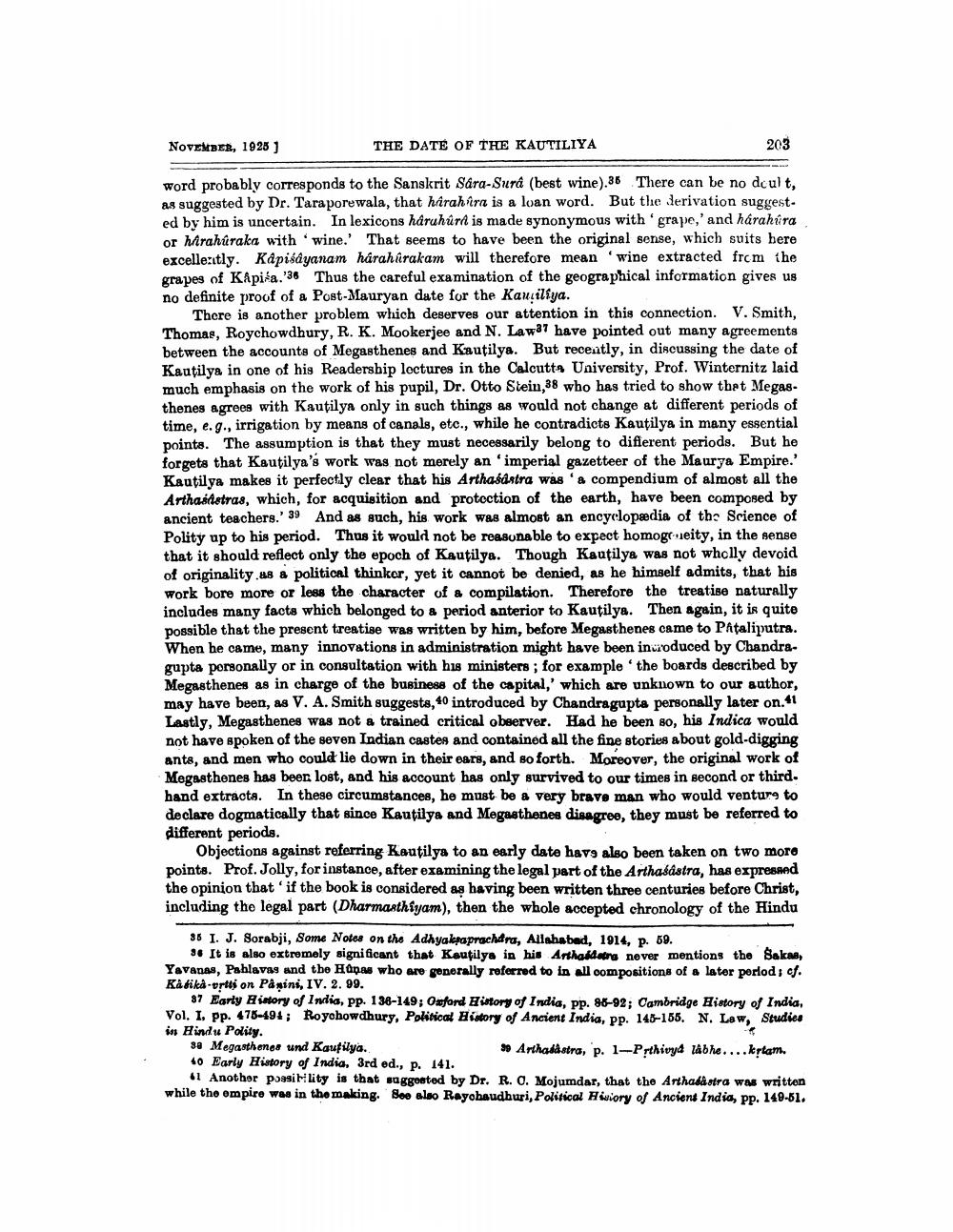________________
NOVEMBER, 1925)
THE DATE OF THE KAUTILIYA
203
word probably corresponds to the Sanskrit Sara-Surá (best wine).36 There can be no dcult, as suggested by Dr. Tara porewala, that hirahira is a loan word. But the derivation suggest. ed by him is uncertain. In lexicons hâruhûrd is made synonymous with grape,' and hárahúra or harahúraka with wine.' That seems to have been the original sense, which suits here excellently. Kapisayanam haraharakam will therefore mean wine extracted from the grapes of Kapića.'36 Thus the careful examination of the geographical information gives us no definite proof of a Post-Mauryan date for the Kaurillya.
There is another problem which deserves our attention in this connection. V. Smith, Thomas, Roychowdhury, R. K. Mookerjee and N. Lawat have pointed out many agreements between the accounts of Megasthenes and Kautilya. But recently, in discussing the date of Kautilya in one of his Readership loctures in the Calcutta University, Prof. Winternitz laid much emphasis on the work of his pupil, Dr. Otto Stein,38 who has tried to show thet Megasthenes agrees with Kautilya only in such things as would not change at different periods of time, e.g., irrigation by means of canals, etc., while he contradicts Kautilya in many essential points. The assumption is that they must necessarily belong to different periods. But he forgets that Kautilya's work was not merely an 'imperial gazetteer of the Maurya Empire.' Kautilya makes it perfectly clear that his Arthasastra was '& compendium of almost all the Arthastras, which, for acquisition and protection of the earth, have been composed by ancient teachers. 39 And as such, his work was almost an encyclopædia of ths Science of Polity up to his period. Thus it would not be reasonable to expect homogeneity, in the sense that it should reflect only the epoch of Kautilya. Though Kautilya was not wholly devoid of originality as a political thinkor, yet it cannot be denied, as he himself admits, that his work bore more or less the character of a compilation. Therefore the treatise naturally includes many facts which belonged to a period anterior to Kautilya. Then again, it is quite possible that the present treatise was written by him, before Megasthenes came to Pataliputra. When he came, many innovations in administration might have been inwoduced by Chandragupta porsonally or in consultation with his ministers; for example the boards described by Megasthenes as in charge of the business of the capital,' which are unknown to our author, may have been, as V. A. Smith suggests, 40 introduced by Chandragupta personally later on.41 Lastly, Megasthenes was not a trained critical observer. Had he been so, his Indica would not have spoken of the seven Indian castes and contained all the fine stories about gold digging ants, and men who could lie down in their ears, and so forth. Moreover, the original work of Megasthenes has been lost, and his account has only survived to our times in second or third. hand extracts. In these circumstances, he must be a very brave man who would venture to declare dogmatically that since Kautilya and Megasthenes disagree, they must be referred to different periods.
Objections against referring Kautilya to an early date have also been taken on two moro points. Prof. Jolly, for instance, after examining the legal part of the Arthasástra, has expressed the opinion that if the book is considered as having been written three centuries before Christ, including the legal part (Dharmasthiyam), then the whole accepted chronology of the Hindu
36 I. J. Sorabji, Some Notes on the Adhyakraprachdra, Allahabad, 1914, p. 59.
34 It is also extremoly significant that Kautilya in his Artha katra nover mentions the Saka Yavanas, Pahlavas and the Hapus who are generally referred to in all compositions of a lator porlod; of. Kafika-ortti on Pånini, IV. 2. 99.
87 Early History of India, pp. 138-149; Oxford History of India, pp. 88-92; Cambridge History of India, Vol. I. Pp. 475-491; Roychowdhury, Political History of Ancient India, pp. 146-155. N. Law, Studies in Hindu Polity. 30 Megasthenes und Kaufilya.
Arthadastra, p. 1-Pithivyd labhe....krlam. 40 Early History of India, 3rd ed., p. 141.
41 Another poasility is that suggested by Dr. R. O. Mojumdar, that the Arthadastra was written while the empire was in the making. See slao Raychaudhuri, Political Hiory of Ancient India, pp. 149-51.




